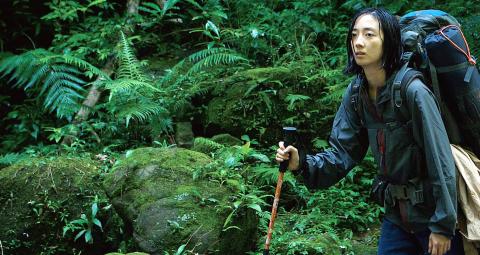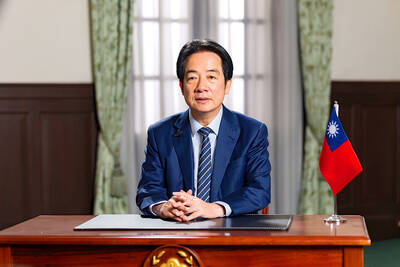At face value, Foret Debussy is a stunningly shot Taiwanese version of Survivor, featuring mother-and-daughter duo Lu Yi-ching (陸弈靜) and Gwei Lun-mei (桂綸鎂), who are hiding deep in the forest due to a terrible tragedy that tortures them constantly.
Despite the backstory and despair-filled atmosphere, most of the actual sequences focus on them trying to survive and the hardships they face — from trying to fashion a canopy to shelter from the rain to fishing with hand-made rods to ingesting poison berries.
This is the first full-length feature by director Kuo Cheng-chui (郭承衢), who also cast Lu and Gwei as a mother and daughter eight years ago in his short film Family Viewing (闔家觀賞). Kuo calls Foret Debussy a “phytoncide film,” and green is indeed all you will see throughout. The title alludes to how composer Claude Debussy was deeply inspired by nature, and as you can image, his music features prominently in the film.

Photo courtesy of Warner Bros
Gwei plays the wan, silent and tortured persona perfectly, languishing in the past as her mother tries to keep them alive despite her own grief, which does erupt in bursts. The dialogue is sparse, but every sentence counts — we basically find out what happened through aural flashbacks and the few sentences exchanged between the two.
Here’s an example: “Did you ever think about the consequences?” Lu asks Gwei while she tries to unsuccessfully light a fire. After a very long pause, Gwei replies calmly, “You would have done the same.” Then they carry on with their tasks in silence, and finally Lu walks away.
This is a testament to the acting skills of the two protagonists as their sorrow, their complicated feelings toward each other and the suffocating tension surrounding them remain clear and powerful even though nothing significant is actually happening in the film. The otherworldly environment and surrealness of the whole situation also adds to the intrigue.
There also seems to be an environmental protection theme behind the film, but is only directly alluded to in two sequences. Perhaps showing the fact that there are still such pristine and untouched landscapes in Taiwan is enough.
Unfortunately, the story stops halfway through the film. There are no more flashbacks, or any dialogue at all for that matter, as it becomes sort of a vehicle for Gwei to show off her acting chops (which will probably win her some acting awards) and the production team to flaunt their brilliant visuals. It meanders on and on, and all the tension and intrigue that made the first half interesting turns into pure anguish and desperation, and one starts to wonder what is the point of the film and where it is going.
At first, the camera sequences work beautifully with the lush scenery, using a mix of static shots, wide pans and hand-held camera closeups while playing with depth of field to create compelling moods and effects. A memorable sequence takes place when Gwei’s character reminisces of a past conversation while standing with her face very close to a tree. The camera zooms in on her face, then circles the tree in an extreme close-up fashion where we can clearly see the moss, bark and leaves and slowly returns to Gwei’s face from the other side as the memory concludes.
But that was when there was still a story. As the film moves on and the story completely stops, these techniques become vanity flourishes as they lose their connotation. Soon, the endless greenery turns claustrophobic — which is probably the director’s intent, but it could have been handled in a more eventful way. While it is an arthouse film, the way the story is revealed in the first half already departs from the norm enough while still being entertaining. Sometimes you don’t have to go further than that.

This month the government ordered a one-year block of Xiaohongshu (小紅書) or Rednote, a Chinese social media platform with more than 3 million users in Taiwan. The government pointed to widespread fraud activity on the platform, along with cybersecurity failures. Officials said that they had reached out to the company and asked it to change. However, they received no response. The pro-China parties, the Chinese Nationalist Party (KMT) and Taiwan People’s Party (TPP), immediately swung into action, denouncing the ban as an attack on free speech. This “free speech” claim was then echoed by the People’s Republic of China (PRC),

Most heroes are remembered for the battles they fought. Taiwan’s Black Bat Squadron is remembered for flying into Chinese airspace 838 times between 1953 and 1967, and for the 148 men whose sacrifice bought the intelligence that kept Taiwan secure. Two-thirds of the squadron died carrying out missions most people wouldn’t learn about for another 40 years. The squadron lost 15 aircraft and 148 crew members over those 14 years, making it the deadliest unit in Taiwan’s military history by casualty rate. They flew at night, often at low altitudes, straight into some of the most heavily defended airspace in Asia.

Many people in Taiwan first learned about universal basic income (UBI) — the idea that the government should provide regular, no-strings-attached payments to each citizen — in 2019. While seeking the Democratic nomination for the 2020 US presidential election, Andrew Yang, a politician of Taiwanese descent, said that, if elected, he’d institute a UBI of US$1,000 per month to “get the economic boot off of people’s throats, allowing them to lift their heads up, breathe, and get excited for the future.” His campaign petered out, but the concept of UBI hasn’t gone away. Throughout the industrialized world, there are fears that

The Democratic Progressive Party (DPP) controlled Executive Yuan (often called the Cabinet) finally fired back at the opposition-controlled Legislative Yuan in their ongoing struggle for control. The opposition Chinese Nationalist Party (KMT) and Taiwan People’s Party (TPP) acted surprised and outraged, but they should have seen it coming. Taiwan is now in a full-blown constitutional crisis. There are still peaceful ways out of this conflict, but with the KMT and TPP leadership in the hands of hardliners and the DPP having lost all patience, there is an alarming chance things could spiral out of control, threatening Taiwan’s democracy. This is no